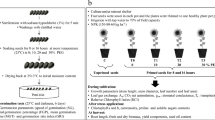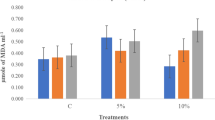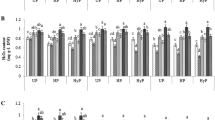Abstract
An experiment was conducted to evaluate the effect of different seed priming methods to enhance the polyethylene glycol-6000 (PEG-6000) stress tolerance in rice (Oryza sativa L.). Seeds were subjected to different priming treatments such as water, PEG, and salicylic acid (SA). The primed seeds were grown for 8 days and then the seedlings were subjected to PEG (15%) stress. The different biochemical responses were studied 2 days after treatment. Under PEG stress, the root length was higher in PEG and SA-primed sets as compared to water-primed, while the shoot height had no change. SA-primed increased photosynthetic pigment content and Chla/Chlb of rice under PEG stress. Net photosynthetic rate and water use efficiency were higher in PEG and SA-primed sets as compared to water-primed under PEG stress. SA-primed enhanced the activities of superoxide dismutase and peroxidase, but decreased the activity of catalase under PEG stress. Proline content was lower in PEG-primed, but higher in SA-primed as compared to water-primed treatment. The study thus suggests the use of SA-priming as a more effective strategy to alleviate the PEG induced stress in rice.
Access this chapter
Tax calculation will be finalised at checkout
Purchases are for personal use only
Preview
Unable to display preview. Download preview PDF.
Similar content being viewed by others
References
Nemeth, M., Janda, T., Hovarth, E., Paldi, E., Szali, G.: Exogenous salicylic acid increases polyamine content but decrease drought tolerance in maize. Plant Sci. 162, 569–574 (2002)
Kang, G.Z., Wang, Z.X., Sun, G.C.: Participation of H2O2 in enhancement of cold chilling by salicylic acid in banana seedlings. Acta Bot. Sin. 45, 567–573 (2003)
Arfan, M., Athar, H.R., Ashraf, M.: Does exogenous application of salicylic acid through the rooting medium modulate growth and photosynthetic capacity in two differently adapted spring wheat cultivars under salt stress? J. Plant Physiol. 6, 685–694 (2007)
Yang, Y.N., Qi, M., Mei, C.S.: Endogenous salicylic acid protects rice plants from oxidative damage caused by aging as well as biotic and abiotic stress. Plant J. 40, 909–919 (2004)
Beyer, W.F., Fridovich, I.: Assaying for superoxide dismutase activity: some large consequences of minor changes in conditions. Anal. Biochem. 161, 559–566 (1987)
Chance, B., Maehly, A.C.: Assay of catalase and peroxidases. Methods Enzymol 11, 764–775 (1955)
Hayat, Q., Hayat, S., Irfan, M., Ahmad, A.: Effect of exogenous salicylic acid under changing environment: a review. Environ. Exp. Bot. 68, 14–25 (2010)
Korkmaz, A., Uzunlu, M., Demirkiran, A.R.: Treatment with acetyl salicylic acid protects muskmelon seedlings against drought stress. Acta Physiol. Plant. 29, 503–508 (2007)
Fariduddin, Q., Hayat, S., Ahmad, A.: Salicylic acid influences net photosynthetic rate, carboxylation efficiency, nitrate reductase activity, and seed yield in Brassica juncea. Photosynthetica 41, 281–284 (2003)
Hayat, S., Hasan, S.A., Fariduddin, Q., Ahmad, A.: Growth of tomato (Lycopersicon esculentum) in response to salicylic acid under water stress. J. Plant Interact. 3, 297–304 (2008)
Kadioglu, A., Saruhan, N., Saglam, A., Terzi, R., Acet, T.: Exogenous salicylic acid alleviates effects of long term drought stress and delays leaf rolling by inducing antioxidant system. Plant Growth Regul., doi:10.1007/s10725-010-9532-3
Janda, T., Szalai, G., Rios-Gonzales, K., Veisz, O., Paldi, E.: Comparative study of frost tolerance and antioxidant activity in cereals. Plant Sci. 164, 301–306 (2003)
Author information
Authors and Affiliations
Corresponding author
Editor information
Editors and Affiliations
Rights and permissions
Copyright information
© 2012 Springer-Verlag GmbH Berlin Heidelberg
About this chapter
Cite this chapter
Li, X., Zhang, L. (2012). SA and PEG-Induced Priming for Water Stress Tolerance in Rice Seedling. In: Zhu, E., Sambath, S. (eds) Information Technology and Agricultural Engineering. Advances in Intelligent and Soft Computing, vol 134. Springer, Berlin, Heidelberg. https://doi.org/10.1007/978-3-642-27537-1_104
Download citation
DOI: https://doi.org/10.1007/978-3-642-27537-1_104
Publisher Name: Springer, Berlin, Heidelberg
Print ISBN: 978-3-642-27536-4
Online ISBN: 978-3-642-27537-1
eBook Packages: EngineeringEngineering (R0)




